Since many Unifi users have got Turbo speed now, more and more people are asking why their wifi is so slow. Unfortunately many are misled by those AC1200, AC1750, AC2400 numbers so here's a guide to what actual speed you can achieve. Now, just to clarify, this is about WiFi speed not internet speed but in order to get max internet speed, you first have to get your wifi in order.
tl;dr Maximum WiFi Speeds
Here's a tl;dr of the max wifi speed that I've tested. Remember, in order to get max speed, your device must equal or better the wifi router.
| Phone | Laptop | Tablet | |
| 2.4Ghz 2x2 | 91.57 Mbps | 92.1 Mbps | - |
| 5Ghz 1x1 | 240.53 Mbps | 244 Mbps | - |
| 5Ghz 2x2 | 343.66 Mbps | 357 Mbps | 518.79 Mbps |
| 5Ghz 3x3 | - | 875 Mbps | - |
Gigabit Ethernet: 934 Mbps (for ref)
Faster speeds coming when I test the faster wifi routers.
AC Rating
The first thing, those AC numbers or Rating. These are there to
The numbers give an indication of the speed of the router but they're mostly there because marketing needed a shorter way to describe the router. So instead of "2.4Ghz 2x2 MIMO and 5Ghz 2x2 MIMO", they use AC1200. Much simpler but just remember no way you'll get 1200Mbps from it.
TM's TP-Link C1200 as an example
Many people have this wifi router since it's a freebie from TM. It is AC1200.
Max 5Ghz link speed: 866Mbps (2x2 5Ghz wifi streams)
Max 2.4Ghz link speed: 300Mbps (2x2 2.4Ghz wifi streams)
So 866+300 = 1200 (yes, marketing did the math)
2x2, 3x3 MIMO
If you wondering what is that 2x2 wifi streams. It's something like this.
2x2 means 2 transmit and 2 receive.
MIMO (multiple in/multiple out) means the wifi can receive,send more than one wifi stream at the same time. Everything is MIMO now.
streams are sometimes called chains. Some people use the term antenna. Not wrong. One stream needs one antenna to transmit. Then you look at the C1200 which is 2x2 but it has 3 antennas. How leh? That one I explain later.
Which brings us to the speed of each stream. It can be more but let's stick to this for now.
One 5Ghz stream = 433Mbps
One 2.4Ghz stream = 150Mbps
Therefore for the TP-Link C1200, for 5Ghz, 2 streams is 2 x 433Mbps = 866Mbps.
Same for 2.4Ghz, 2 x 150Mbps = 300Mbps.
Add these together and you'll get the 1200 in AC1200.
Your laptop, phone
Alright, so your laptop and phone also has the same things. 1x1, 2x2, 3x3 MIMO. In order to get max speed, your phone must equal or better the wifi router.
Now, this is where a lot of questions arises. Some people might have a great router but their laptop or phone not so good. And vice-versa.
1. Most phones are 1x1
2. Some only have 2.4Ghz, no 5Ghz
3. Most laptops are 2x2
4. Some are 3x3
5. Cheaper laptops only have 2.4Ghz
So you see, if you connect a phone with 5GHz AC 1x1 to a C1200 2x2, the link speed will only be 433Mbps.
Link Speed vs Actual Speed
You might think, 433Mbps link speed is damn good already. But when you try, your speeds are much slower. Yeah, you'll never get full link speed. Why? Actually I'm not entirely sure so I'll leave that to Google.

MacBook Pro Retina 2013 3x3 5Ghz Link Speed to a 1x1 hAP AC Lite
As a rough guesstimate for actual speed, I like to use 60% which is already a very optimistic number for the speed that you may get. You may get higher speeds, probably not, but very easy to get lower speeds.
1x1 - Link: 433Mbps - IRL: 260Mbps
2x2 - Link: 866Mbps - IRL: 520Mbps
3x3 - Link: 1299Mbps - IRL: 779Mbps
Other Factors
In real life (IRL), other things will affect the final speed that you get.
1. Distance
2. Line of sight
3. Door
4. Wall
5. Interference from neigbour's wifi
So many things, I'm just going to list 5.
WiFi speed tests
To give you an idea of the speeds, I did a few tests below.
The test is a 30 second iPerf3 TCP test. Data is sent from the server via the respective wifi router to the device.
CODE
iperf3 -c 10.0.1.80 -R -i 4 -t 30
The command for iperf3 where applicable. iPhones are using an app called WiFiPerf which is iPerf3 compatible.
*Note that these are tests of just the wifi. No internet involved. Get the wifi speed sorted out before worrying about the internet. So, again, this is all local area network,
**I'm lazy to edit it so if you see single chain, dual or triple chain, it means 1x1, 2x2 or 3x3 respectively.
Stuff Used
Server: Thinkcentre M73 - Ubuntu 18.04 LTS - iperf3 3.1.3
Laptop: MacBook Pro Retina 2013 - MacOS 10.13.6 - 2.4Ghz Dual Chain - 5Ghz Triple Chain - iperf 3.6
Phone: iPhone 6s - iOS 12.0 - Dual Chain - WiFiPerf 3.2
Network: Gigabit - Cabling: Cat5e
Distance: Approximately 4ft from device to wifi router.
WiFi Routers (to be tested)
1. Mikrotik hAP AC Lite - 2.4Ghz Dual Chain - 5Ghz Single Chain - AC750 (done)
2. Mikrotik hAP AC2 - 2.4Ghz Dual Chain - 5Ghz Dual Chain - AC1200
3. Mikrotik hAP AC - 2.4Ghz Triple Chain - 5Ghz Triple Chain - AC1750
4. Aztech FG7008GR - 2.4Ghz Triple Chain - 5Ghz Quad Chain - AC2400
5. D-Link DIR-878L - 2.4Ghz Quad Chain - 5Ghz Quad Chain - AC2600
Notes
• RouterOS 6.44beta6 (11/9/2018)
• hAP AC Lite: 3x100M ethernet bonding
*because the hAP AC Lite only has 100Mbps network ports, I bonded 3 ports (300Mbps) to cater for WiFI AC speeds.
• The only tuning I did was lowering transmit power as I was only 4ft away from the wifi routers.
• WiFi chip features such as WMM, adaptive noise immunity, beam forming, or band steering are disabled.
Radio Environment
2.4Ghz Scanner and Frequency Usage
Tests were done in my house in the afternoon on a weekend. Typical double storey intermediate link house. Quite a few 2.4Ghz APs around but still can be considered good.
Since it's a weekend, more people are home and using their phones and laptops. It gets better in the afternoon on a weekday or in the early morning when everyone is asleep.
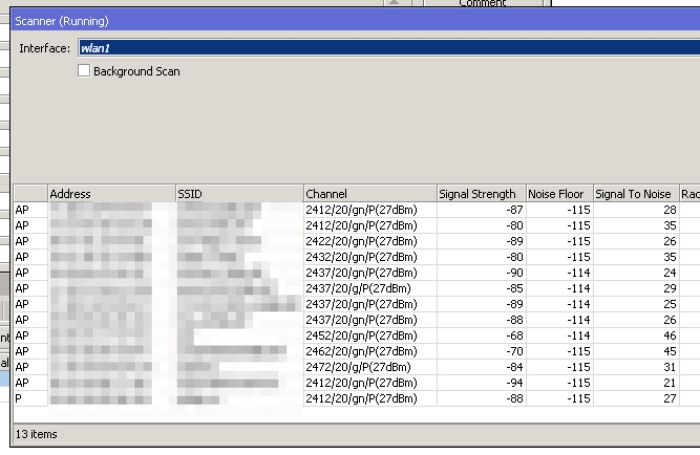

5Ghz Scanner and Frequency Usage
Very clean. There's only one 5Ghz AP and the signal is very weak.

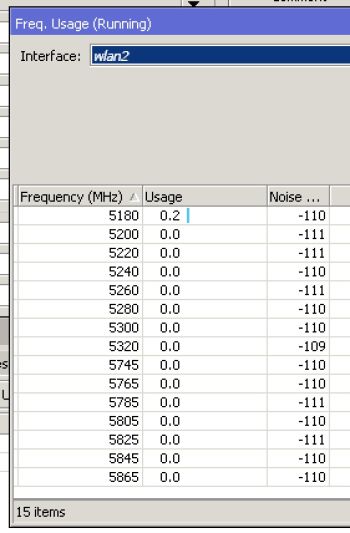
Ethernet Speed Test (Control)
| Phone 6s | MBPR | |
| Ethernet | 94.41 Mbps | 934 Mbps |
» Click to show Spoiler - click again to hide... «
Mikrotik hAP AC Lite - 2.4Ghz Dual Chain - 5Ghz Single Chain - AC750
| iPhone 6s | link | MBPR | link | |
| 2.4Ghz Dual Chain (Early Morning) | 91.57 Mbps | 144 Mbps | - | - |
| 2.4Ghz Dual Chain (Afternoon) | 79.29 Mbps | 144 Mbps | 92.1 Mbps | 144 Mbps |
| 5Ghz Single Chain | 240.53 Mbps | 433 Mbps | 244 Mbps | 433 Mbps |
» Click to show Spoiler - click again to hide... «
» Click to show Spoiler - click again to hide... «
Mikrotik hAP AC2 - 2.4Ghz Dual Chain - 5Ghz Dual Chain - AC1200
| iPhone 6s | link | MBPR | link | |
| 2.4Ghz Dual Chain | - | - | ||
| 5Ghz Dual Chain | 340.88 Mbps | 866 Mbps | 357 Mbps | 866 Mbps |
» Click to show Spoiler - click again to hide... «
Mikrotik hAP AC - 2.4Ghz Triple Chain - 5Ghz Triple Chain - AC1750
| iPhone 6s | link | MBPR | link | |
| 2.4Ghz Dual Chain | 87.05 Mbps | 144 Mbps | 77 Mbps | 144 Mbps |
| 5Ghz Dual Chain | 343.66 Mbps | 780 Mbps | - | - |
| 5Ghz Triple Chain | - | - | 420 Mbps | 950 Mbps |
Aztech FG7008GR - 2.4Ghz Triple Chain - 5Ghz Quad Chain - AC2400
| iPhone 6s | link | MBPR | link | iPad 2017 | link | |
| 2.4Ghz Dual Chain | - | - | - | - | - | - |
| 5Ghz Dual Chain | 304.96 Mbps | - | - | - | 518.79 Mbps | - |
| 5Ghz Triple Chain | - | - | 875 Mbps | 1300 Mbps | - | - |
» Click to show Spoiler - click again to hide... «
D-Link DIR-878L - 2.4Ghz Quad Chain - 5Ghz Quad Chain - AC2600
| iPhone 6s | MBPR | |
| 2.4Ghz Dual Chain | xxx | xxx |
| 2.4Ghz Triple Chain | xxx | xxx |
| 5Ghz Single Chain | xxx | xxx |
| 5Ghz Triple Chain | xxx | xxx |
This post has been edited by soonwai: Sep 21 2018, 09:05 AM


 Sep 17 2018, 11:05 PM, updated 3y ago
Sep 17 2018, 11:05 PM, updated 3y ago
 Quote
Quote
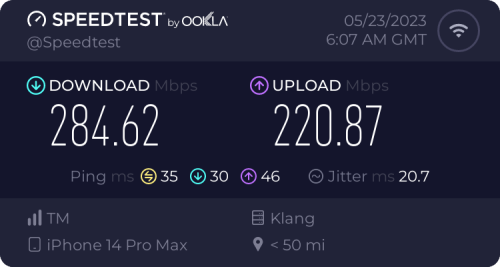
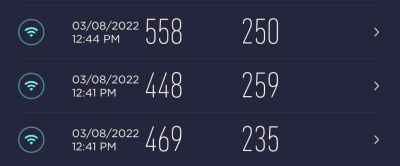
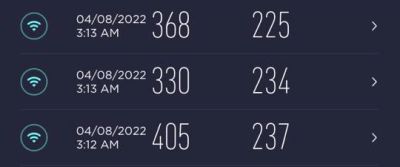
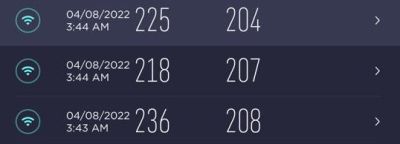
 0.0227sec
0.0227sec
 0.81
0.81
 7 queries
7 queries
 GZIP Disabled
GZIP Disabled